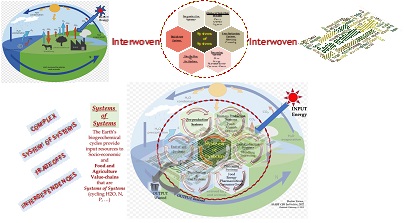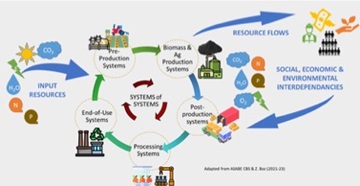Why CBSI?
Addressing the Grand Challenges
The world is now faced with multiple interacting challenges. Demand is increasing for water, energy, food, and other bioproducts at the same time as availability of natural resources is decreasing. Additionally, we are faced with a changing climate and the necessity of reducing net greenhouse gas (GHG) emissions that contribute to global warming. These challenges influence all sectors of societies worldwide, including those involved in providing food, fiber, and other biomass-based products to meet human needs—the bioeconomy.
The bioeconomy is central to addressing each of these challenges, and arguably the most critical sector. According to the McKinsey Global Institute, “As much as 60 percent of the physical inputs to the global economy could be, in principle, produced biologically.”
The following target solutions are currently being pursued by various organizations to address these challenges:
- Increase supply of food by twofold for the expanding world population without using more fresh water and land.
- Increase efficiency of natural resources use, reduce loss of freshwater quality and soil health, and minimize (eliminate? avoid?) degradation of the Earth’s ecosystems.
- Produce near-zero wastes through reuse, recycling, and cascading products to benefit society and the environment.
- Lower the contributions of food and agricultural systems to GHG emissions, pollution, and climate change.
- Significantly increase production of biomass to meet demands for biobased feedstocks to replace fossil carbon
- Make food and agriculture a solution to climate change rather than a major contributor to it.
An overarching question is: How can we address these multiple grand challenges to sustainably provide safe and healthy food and other bioproducts for our growing population while simultaneously conserving our diminishing supplies of natural resources, decreasing environmental contamination, and reducing greenhouse gases to limit changes in climate?
Current Food and Agricultural Systems
Most current food and agricultural systems follow a linear path of take-make-use-waste-pollute (Figure 1), The problems with this model are now widely acknowledged:
- It is prone to degrading and depleting the natural resource base (g., soils, surface and ground water, nutrients)
- It generates pressure on the environment (g., water pollution, greenhouse gas (GHG) emissions, loss of biodiversity)
- It contributes to climate change.
The bioeconomy has biomass as its primary feedstock for creating goods and services. Different decision makers control activities along bioeconomy systems value chains, which leads to complexities and uncertainties in product supplies. In today’s systems, there are few public or private recovery infrastructures for productively using unwanted outputs. This causes significant waste and lost resources, which CBSI is targeting to change.

Figure 1. Illustrates the complex interwoven web of natural systems, agri-food systems,and socio-economic systems that interact in circular bioeconomy systems.
Circular Bioeconomy Systems Solutions
Circular bioeconomy systems (CBS) concepts represent a new level of thinking in which nature’s ecosystems, human agrifood systems, and socio-economic systems are interwoven systems of systems (Figure 2), in which biomass resources stay in productive use as long as possible.

Figure 2. Illustrates the complex interwoven web of natural systems, agri-food systems, and socio-economic systems that interact in circular bioeconomy systems.
Solutions addressing a problem of one constituent system often create unintended serious issues in other systems. The answers may lie in the adaptation of the fact that efficiency and sustainability of nature are a result of its many circular systems that continuously interact and dynamically respond to changing conditions (Figure 3). One organism’s “waste” is another organism’s “food, energy, and nutrients” in a continuous loop of growth, decay, and reuse.
Target Achievements by 2050:
1. Increase efficiencies of natural resource use by 60%
2. Increase productivity by 70%.
3. Have net positive effect on atmospheric GHG emissions and produce near zero waste.
4. Decrease N and P losses to the environment by 50%.
5. Regenerate health of soils, freshwater resources, and ecosystems.
6. Increase sustainability, resilience, equity, and safety of food supplies.
An alternative can be for us to transition current systems into circular bioeconomy systems by using five principles of circularity adopted by the CBSI:
- Increase input efficiency
- Design out waste and pollution (recover discarded wastes for productive use
- Keep products and materials in continued use as long as possible
- Regenerate natural systems
- Provide economic benefits
A more-circular bioeconomy can contribute to address society’s multiple goals and enable one to better understand tradeoffs. Required knowledge, techniques, and skills will emerge from the integration of disciplinary perspectives and innovative solutions in the context of whole systems.

Figure 3. A Simplified circular bioeconomy systems diagram showing cycling of bioproducts throughout entire value chains.
CBSI: Bringing Stakeholders Together
In 2020, the American Society of Agricultural and Biological Engineers (ASABE) explored the complexity and obstacles in transforming the current linear food and agriculture to circular bioeconomy systems (CBS) and envisioned pathways for completing the transition by 2050. A major conclusion was the essential need to take systems approaches and build partnerships for merging perspectives of systems, disciplines, and stakeholders to develop use-inspired research, educational, and outreach programs.
Since 2020, ASABE has formed several working groups made of multiple disciplines, stakeholders, policy makers, and professional societies’ presidents to intensively address: What actions should professional societies take, within themselves and together with other societies, that would lead to broad adaptation of circularity to achieve targets set by the working groups (see Box). These groups diligently worked to build networks to communicate, collaborate, and connect with multiple societies; engaged prominent organizations to develop multi-society R&D goals and envision pathways to circularity; and held meetings, outreach, and training workshops.
In 2023, the ASABE Board of Trustees approved the formation of CBSI to operate as an interdisciplinary entity. The institute’s overall objective is to build multidisciplinary partnerships that innovate to advance circular food and agricultural systems and embrace our vision of “a healthy planet driven by a vibrant, sustainable circular bioeconomy producing plentiful food, feed, forest products and renewable resources.”
Our immediate challenges are for leaders of multiple disciplines and stakeholders to come together and focus on developing new knowledge, techniques, and skills needed to transform existing systems into more-circular bioeconomy systems. The transition requires that we take a system of systems approach. Having bioproducts and byproducts (not waste) of bioeconomy systems become dominant feedstocks replacing fossil carbon to synthesize materials for all human needs is a worthy goal to sustain our life-support systems.
We need you to make the transformation to circular systems a reality. Join us and be a part of this important work.
*View this article as PDF here.
